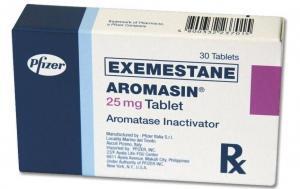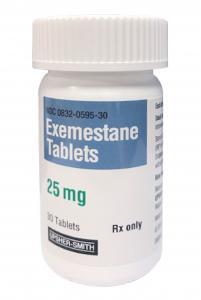Aromasin (Exemestane)

Dosages
Aromasin 25 mg
| Quantity | Price per pill | Total price | |
|---|---|---|---|
| 15 | $5.00 | $75.00 | |
| 30 | $4.10 | $123.00 | |
| 60 | $3.95 | $237.00 | |
| 90 | $3.69 | $332.00 | |
| 120 | $3.56 | $427.00 | |
| 180 | $3.40 | $612.00 | |
| 270 | $3.30 | $891.00 | |
| 360 | $3.20 | $1,152.00 |
Payment & Shipping
Your order is carefully packed and ships within 24 hours. Here's the typical package.
Sized like a regular personal letter (9.4x4.3x0.3 inches), with no indication of its contents.



| Shipping Method | Estimated delivery |
|---|---|
| Express Free for orders over $300.00 | Estimated delivery to the U.S.: 4-7 days |
| Standard Free for orders over $200.00 | Estimated delivery to the U.S.: 14-21 days |









Discount Coupons
- Independence Day - July 4, 2025 10% JULY410
- Labor Day - September 1, 2025 7% LABOR07
- Thanksgiving - November 27, 2025 9% THANKS09
Brand Names
| Manufacturer | Brand Names |
|---|---|
| Natco Pharma Limited | Xtane |
FAQ
Description
 What Is Aromasin (Exemestane)?
What Is Aromasin (Exemestane)?
Aromasin, or Exemestane, is a medication commonly used in the treatment of breast cancer, specifically in postmenopausal women. It belongs to a class of drugs known as aromatase inhibitors, which block the enzyme responsible for estrogen production in the body. Estrogen can promote the growth of certain types of breast cancers, so inhibiting its production is a key strategy in hormone receptor-positive breast cancer treatment. Aromasin is often prescribed after other treatments like tamoxifen, and its central role is in preventing cancer recurrence. Like any medication, it may have side effects, and patients must discuss their medical history and potential risks with their healthcare provider before starting treatment.
Pharmacokinetics
Exemestane is rapidly absorbed from the gastrointestinal tract. Its bioavailability is limited by first-pass metabolism but increases when taken with food. Exemestane is widely distributed and extensively bound to plasma proteins. It is metabolized via oxidation by the cytochrome P450 isoenzyme CYP3 A4 and via reduction by aldoketoreductase. Metabolites are excreted in the urine and feces, and less than 1% of a dose is excreted unchanged in the urine. Exemestane has a terminal elimination half-life of about 24 hours.
Uses and Administration
Exemestane is a selective inhibitor of the aromatase (estrogen synthase) system, similar to formestane. It is used in the treatment of advanced breast cancer in postmenopausal women who are no longer responsive to antioestrogen therapy. It is also used for adjuvant treatment of postmenopausal women with estrogen-receptor-positive early breast cancer. After 2 to 3 years of initial adjuvant tamoxifen treatment, five years of adjuvant hormonal therapy should be given.
The recommended oral dose is 25 mg once daily, preferably after a meal. In patients receiving potent inducers of the cytochrome P450 isoenzyme CYP3A4 (such as rifampicin or phenytoin), the recommended oral dose of exemestane is 50 mg once daily after a meal.
 Adverse Effects and Precautions
Adverse Effects and Precautions
The most frequently reported adverse effects of exemestane are gastrointestinal disturbances, hot flashes, arthralgia, myalgia, sweating, fatigue, and dizziness. Other reported effects include headache, insomnia, drowsiness, depression, skin rashes, alopecia, asthenia, and peripheral and leg edema. Thrombocytopenia and leucopenia have been reported occasionally. Reductions in bone mineral density can occur with long-term use of exemestane. Density should, therefore, be assessed at the start of therapy in those with osteoporosis or at risk of it, and patients should be monitored during therapy.
The use of exemestane is contra-indicated in premenopausal women (particularly in pregnancy).
Effects on the Musculoskeletal System
Exemestane therapy has been found to decrease bone mineral density (BMD) in postmenopausal women with early breast cancer. In one study, the decrease in BMD was seen within 6 months of switching therapy from tamoxifen and was significant at the lumbar spine and hip. In a Scandinavian study, bone mineral density loss with exemestane compared with placebo was modest from the femoral neck and not significant at the lumbar spine; however, it was noted that the changes in the placebo group were more significant than expected, possibly due to the lack of calcium and vitamin D supplementation, and that there is a high incidence of hip fracture in Scandinavia.
Patients starting exemestane therapy should be assessed for baseline bone mineral density. At the same time, those with normal BMD are considered not to need further assessment beyond lifestyle advice. Those with osteopenia should have their bone mineral density monitored and therapeutic interventions made as appropriate.
Interactions
The metabolism of exemestane is mediated by the cytochrome P450 isoenzyme CYP3A4. Rifampicin, a potent inducer of CYP isoenzymes, can decrease plasma concentrations of exemestane. Use with other drugs that induce this isoenzyme may reduce the efficacy of exemestane. Exemestane should also be used cautiously with drugs that are substrates for CYP3A4 and that have a narrow therapeutic index. Significant effects on exemestane clearance by cytochrome P450 isoenzyme inhibitors are considered unlikely. Exemestane should not be given oestrogen-containing drugs as these would negate its pharmacological action.
In the battle against hormone receptor-positive breast cancer, Aromasin proves to be a potent ally, providing patients undergoing treatment with reassurance and effectiveness. Its key function in preventing cancer recurrence and raising survival rates is highlighted by its mode of action, which involves blocking aromatase and lowering estrogen levels. Aromasin is a well-received and clinically validated treatment option that represents a significant advancement in the field of oncology, offering improved prospects for those facing breast cancer.
Drug Nomenclature
International Nonproprietary Names (INNs) in main languages (French, Latin, Russian, and Spanish):
Synonyms: Eksemestaani; Exemestan; Exemestano; Exemestanum; FCE-24304
BAN: Exemestane
USAN: Exemestane
INN: Exemestane [rINN (en)]
INN: Exemestano [rINN (es)]
INN: Exémestane [rINN (fr)]
INN: Exemestanum [rINN (la)]
INN: Ексеместан [rINN (ru)]
Chemical name: 6-Methyleneandrosta-1,4-diene-3,17-dione
Molecular formula: C20H24O2 =296.4
CAS: 107868-30-4
ATC code: L02BG06























